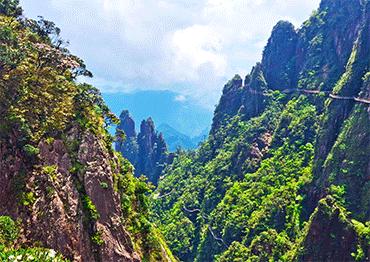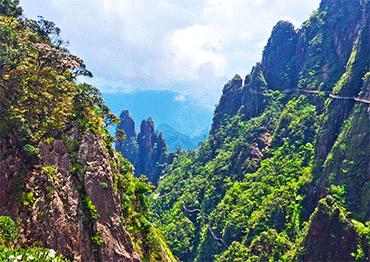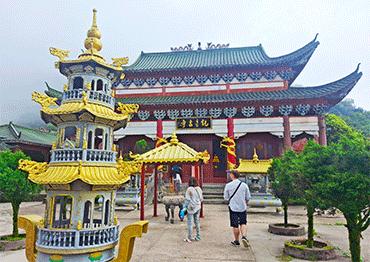Mangshan National Forest Park, located in Yizhang County near Chenzhou in southern Hunan Province, is a magnificent ecological and geological reserve covering nearly 200 square kilometers. The park is renowned for its exceptionally high forest coverage, which supports a diverse array of subtropical flora and fauna, including rare and endemic species such as unique species of horned toad, crocodile newt and pit viper. Owing to its spectacular natural characteristics, Mangshan serves as both a valuable site for scientific study, conservation and as a destination for ecotourism. However, Mangshan does not attract many visitors from other provinces or from outside China, resulting in a relatively peaceful and relaxing atmosphere where visitors can truly connect with nature. Yet evident investment in infrastructure suggests that authorities are keen for Mangshan to capitalize on its clear potential. So now may well be the perfect time to visit Mangshan, after comfortable amenities have been opened, but before throngs of tourists discover it.
One of the park’s most iconic features is the Five Finger Peak, whose dramatic vertical cliffs and forested slopes have drawn comparisons to the celebrated landscapes of Hunan’s more popular destination of Zhangjiajie. The breathtaking scenery at Mangshan is strongly reminiscent of Zhangjiajie, yet it is far quieter. The broader mountain range is distinguished by its Danxia landforms, which are red sandstone formations shaped over millions of years through natural erosion and tectonic uplift. This rich geological context has also made the area well-known for its striking fossils, crystalline formations and rare rocks, many of which are available for purchase in local tourist souvenir shops.
Access to the park is somewhat difficult due to its remote location, approximately two hours’ drive from Chenzhou. However, this inaccessibility probably contributes to the peace and serenity, so the time taken to reach it should be considered a worthwhile investment. Even once you arrive at the park’s west gate and buy the first ticket of many you need to buy, you must travel another 30 minutes within the park on a tourist bus, slowly snaking up the steep cliff edge before you can explore on foot. Fortunately, the journey is enjoyable due to the dramatic scenery along the way. However, even this bus journey does not result in easy access to the desired views. Instead, following the bus ride, guests have the choice between an extensive, hard-to-find, near-vertical hike, or buying additional tickets to ascend a series of steep and long escalators to reach yet another peak. After ascending the mountain using the escalators, visitors finally reach the start of the park’s planned walking path networks.
After traveling extensively upwards, the climate is noticeably cooler. You might become enveloped in clouds as you explore these initial walkways and assorted viewing platforms. However, the park’s “famous” paths, those which dramatically hug the cliffs and reveal once-in-a-lifetime, awe-inspiring views, are inaccessible without the purchase of yet another ticket.
Although undeniably worth the extra cost, it is frustrating that the one-way circular route essentially requires the use of two glass elevators, each of which also requires yet another ticket. While the descending elevator can be avoided with relative ease, in favor of a staircase, the ascending elevator would (like the initial escalators) require a lengthy uphill hike, adding an hour or two to the experience, which already requires the majority of a day to enjoy. Including the ticket required to descend the escalators at the end of the day, it is difficult to imagine how any visitor could enjoy the park without purchasing five or six separate tickets, altogether around 450 yuan (US$62.5). This excludes any additional activities the visitor may choose to buy. It is a shame that a simple all-inclusive ticket is not available. Nevertheless, visitors should not allow this inconvenience to deter them from visiting this premier natural attraction.
If the idea of visiting a national park appeals to you, but the words escalator, glass elevator and ticket give you pause, then your skepticism is understandable. Even the most optimistic traveler may wince upon hearing “Auld Lang Syne” playing through a speaker along a mountain trail, or stumbling upon a two-meter-high snow globe containing a snowman and a smiling polar bear halfway up a cliff edge without any cultural or environmental context. However, experienced travelers in China will be familiar with such unexpected distractions, and it is fair to say that Mangshan National Forest Park has significantly fewer of these artificial elements than many of the country’s more famous attractions. Any minor lack of authenticity in isolated areas of the park is easily overlooked when placed in the context of an expansive and genuinely wild landscape, adorned with spectacular cliffs and dramatic terrain.
In addition to its natural grandeur, Mangshan National Forest Park also offers a range of optional activities for visitors seeking either adventure or cultural enrichment. For thrill-seekers, the park features a via ferrata – a steel-cabled climbing route bolted into the cliffs – which provides a heart-racing yet secure way to experience the mountain’s dramatic heights. While not for the faint-hearted, this activity delivers unparalleled views and a genuine sense of achievement. For those more interested in tranquillity and tradition, the park is also home to a beautifully preserved historical temple and an elegant pagoda, both of which offer insight into the region’s cultural heritage and provide peaceful spaces for quiet reflection. Scattered throughout the park are several rest areas, tea stalls and modest eateries where visitors can pause to enjoy local refreshments while soaking in the scenery.
It is best to be well-prepared for this park. Wear good walking shoes with grip for steep and uneven terrain. Take water, snacks, sunscreen and insect repellent. Ensure you have cash or mobile payment apps for multiple ticket purchases and local vendors as physical cards may not be accepted. You will need at least a light jacket or layers – even in summer, temperatures can vary at higher altitudes.
Beyond the tourist-sections of the park, the surrounding area is known for its geothermal activity, and several nearby hotels make excellent use of this natural resource. These hot spring resorts provide the perfect antidote to a long day of hiking and exploring, allowing visitors to unwind in mineral-rich waters surrounded by forested mountain views. The Mangshan Forest Hot Spring Hotel even offers a panoramic infinity pool, raised high on the mountainside, filled with hot, natural spring water. While the infinity pool closes at 10 pm, the majority of the outdoor and indoor hot springs do not close until midnight, offering extensive access to recuperation for weary hikers after a day in the mountains. Whether soaking in a private hot spring under the stars or enjoying a full-service spa experience, the combination of rugged adventure and deep relaxation makes Mangshan the perfect destination to enjoy natural beauty, healthy exercise and restoration.

 Old Version
Old Version

